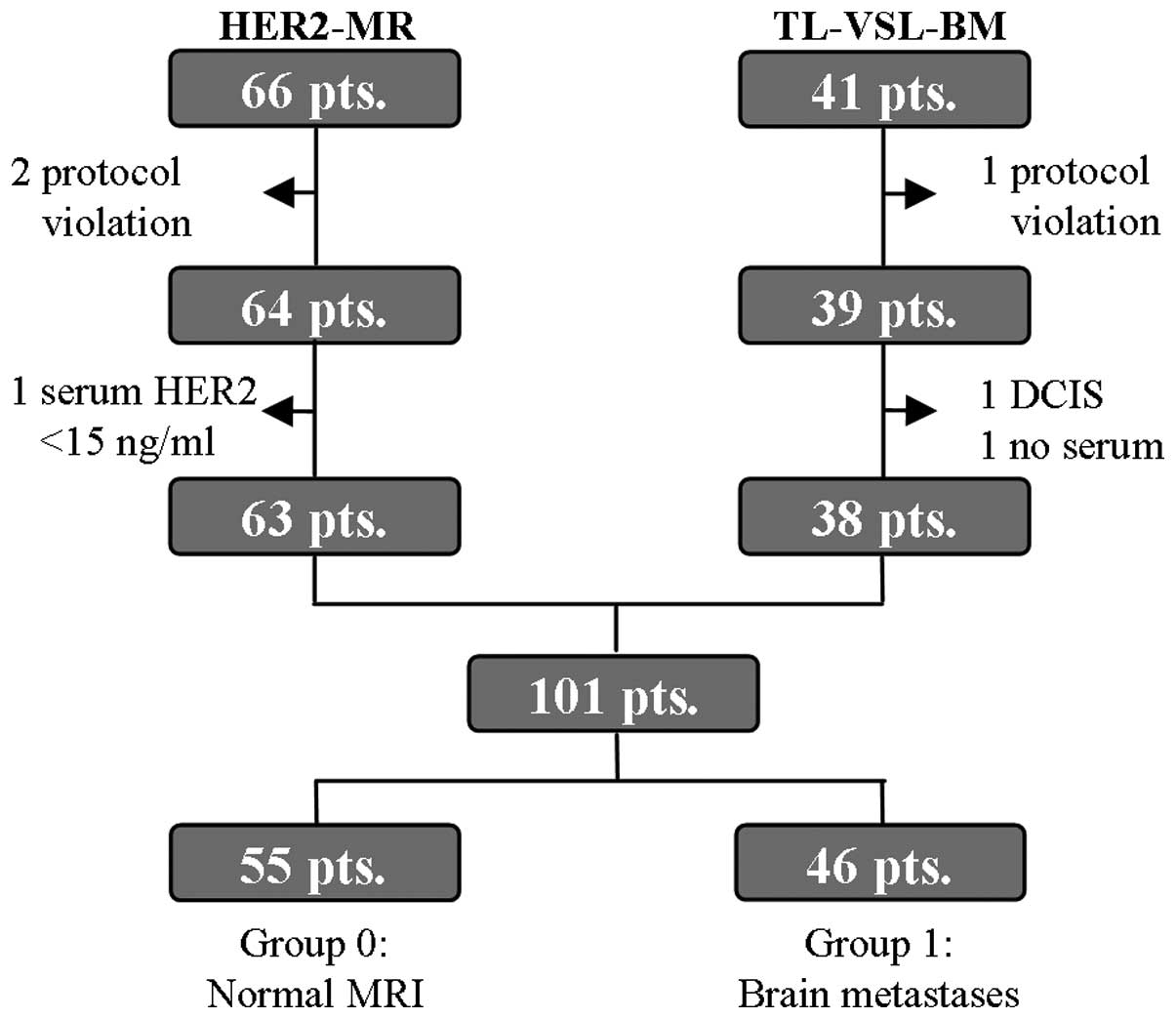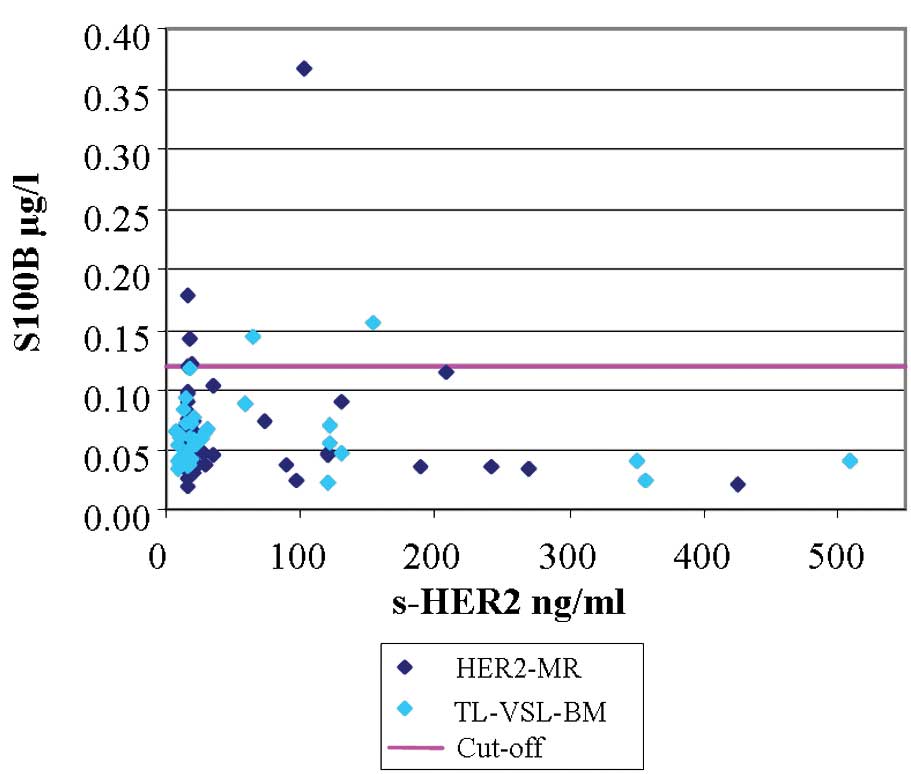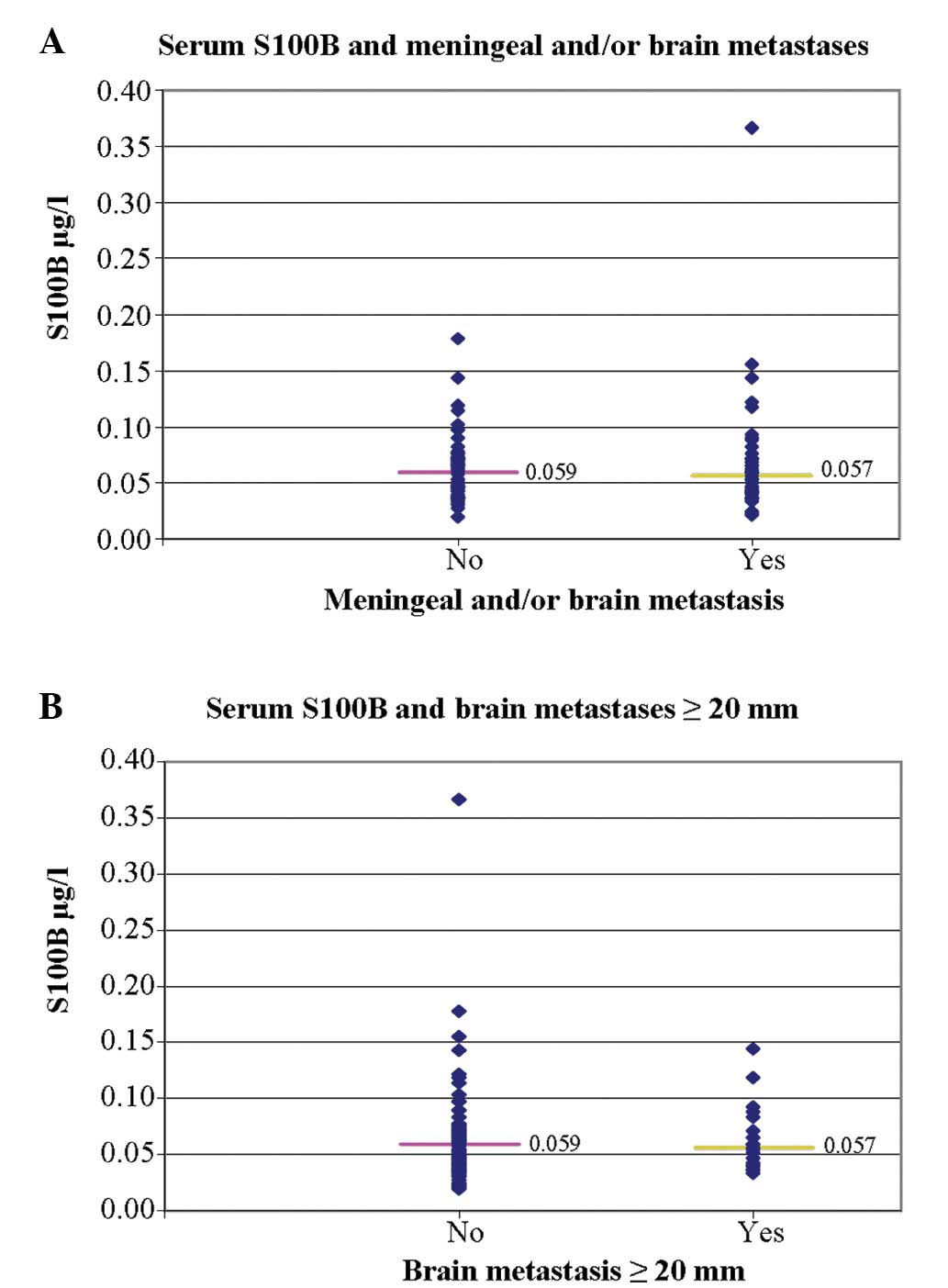|
1
|
NORDCAN. Cancer incidence, mortality,
prevalence and survival in the nordic countries, version 51. March.
2012, Association of the Nordic Cancer Registries. Danish Cancer
Society. http://www-dep.iarc.fr/NORDCAN/DK/StatsFact.asp?cancer=180&country=208.
Accessed November 28, 2012
|
|
2
|
Bendell JC, Domchek SM, Burstein HJ, et
al: Central nervous system metastases in women who receive
trastuzumab-based therapy for metastatic breast carcinoma. Cancer.
97:2972–2977. 2003. View Article : Google Scholar
|
|
3
|
Clayton AJ, Danson S, Jolly S, et al:
Incidence of cerebral metastases in patients treated with
trastuzumab for metastatic breast cancer. Br J Cancer. 91:639–643.
2004.PubMed/NCBI
|
|
4
|
Ono M, Ando M, Yunokawa M, et al: Brain
metastases in patients who receive trastuzumab-containing
chemotherapy for HER2-overexpressing metastatic breast cancer. Int
J Clin Oncol. 14:48–52. 2009. View Article : Google Scholar : PubMed/NCBI
|
|
5
|
Aukema TS, Olmos RA, Korse CM, et al:
Utility of FDG PET/CT and brain MRI in melanoma patients with
increased serum S100B level during follow-up. Ann Surg Oncol.
17:1657–1661. 2010. View Article : Google Scholar : PubMed/NCBI
|
|
6
|
Miller KD, Weathers T, Haney LG, et al:
Occult central nervous system involvement in patients with
metastatic breast cancer: prevalence, predictive factors and impact
on overall survival. Ann Oncol. 14:1072–1077. 2003. View Article : Google Scholar
|
|
7
|
Niwińska A, Tacikowska M and Murawska M:
The effect of early detection of occult brain metastases in
HER2-positive breast cancer patients on survival and cause of
death. Int J Radiat Oncol Biol Phys. 77:1134–1139. 2010.PubMed/NCBI
|
|
8
|
Pauletti G, Dandekar S, Rong H, et al:
Assessment of methods for tissue-based detection of the HER-2/neu
alteration in human breast cancer: a direct comparison of
fluorescence in situ hybridization and immunohistochemistry. J Clin
Oncol. 18:3651–3664. 2000.
|
|
9
|
Slamon DJ, Clark GM, Wong SG, et al: Human
breast cancer: correlation of relapse and survival with
amplification of the HER-2/neu oncogene. Science. 235:177–182.
1987. View Article : Google Scholar : PubMed/NCBI
|
|
10
|
Slamon DJ, Leyland-Jones B, Shak S, et al:
Use of chemotherapy plus a monoclonal antibody against HER2 for
metastatic breast cancer that overexpresses HER2. N Engl J Med.
344:783–792. 2001. View Article : Google Scholar : PubMed/NCBI
|
|
11
|
Piccart-Gebhart MJ, Procter M,
Leyland-Jones B, et al; Herceptin Adjuvant (HERA) Trial Study Team.
Trastuzumab after adjuvant chemotherapy in HER2-positive breast
cancer. N Engl J Med. 353:1659–1672. 2005. View Article : Google Scholar : PubMed/NCBI
|
|
12
|
Romond EH, Perez EA, Bryant J, et al:
Trastuzumab plus adjuvant chemotherapy for operable HER2-positive
breast cancer. N Engl J Med. 353:1673–1684. 2005. View Article : Google Scholar : PubMed/NCBI
|
|
13
|
Kurebayashi J: Biological and clinical
significance of HER2 overexpression in breast cancer. Breast
Cancer. 8:45–51. 2001. View Article : Google Scholar : PubMed/NCBI
|
|
14
|
Carney WP, Neumann R, Lipton A, et al:
Potential clinical utility of serum HER-2/neu oncoprotein
concentrations in patients with breast cancer. Clin Chem.
49:1579–1598. 2003. View Article : Google Scholar : PubMed/NCBI
|
|
15
|
Leitzel K, Teramoto Y, Sampson E, et al:
Elevated soluble c-erbB-2 antigen levels in the serum and effusions
of a proportion of breast cancer patients. J Clin Oncol.
10:1436–1443. 1992.
|
|
16
|
Molina R, Escudero JM, Muñoz M, et al:
Circulating levels of HER-2/neu oncoprotein in breast cancer. Clin
Chem Lab Med. 50:5–21. 2012. View Article : Google Scholar : PubMed/NCBI
|
|
17
|
Carney WP, Neumann R, Lipton A, et al:
Monitoring the circulating levels of the HER2/neu oncoprotein in
breast cancer. Clin Breast Cancer. 5:105–116. 2004. View Article : Google Scholar : PubMed/NCBI
|
|
18
|
Finn RS, Gagnon R, Di LA, et al:
Prognostic and predictive value of HER2 extracellular domain in
metastatic breast cancer treated with lapatinib and paclitaxel in a
randomized phase III study. J Clin Oncol. 27:5552–5558. 2009.
View Article : Google Scholar : PubMed/NCBI
|
|
19
|
Esteva FJ, Cheli CD, Fritsche H, et al:
Clinical utility of serum HER2/neu in monitoring and prediction of
progression-free survival in metastatic breast cancer patients
treated with trastuzumab-based therapies. Breast Cancer Res.
7:R436–R443. 2005. View
Article : Google Scholar : PubMed/NCBI
|
|
20
|
Bramwell VH, Doig GS, Tuck AB, et al:
Changes over time of extracellular domain of HER2 (ECD/HER2) serum
levels have prognostic value in metastatic breast cancer. Breast
Cancer Res Treat. 114:503–511. 2009. View Article : Google Scholar : PubMed/NCBI
|
|
21
|
Lipton A, Ali SM, Leitzel K, et al:
Elevated serum Her-2/neu level predicts decreased response to
hormone therapy in metastatic breast cancer. J Clin Oncol.
20:1467–1472. 2002. View Article : Google Scholar : PubMed/NCBI
|
|
22
|
Ali SM, Carney WP, Esteva FJ, et al: Serum
HER-2/neu and relative resistance to trastuzumab-based therapy in
patients with metastatic breast cancer. Cancer. 113:1294–1301.
2008. View Article : Google Scholar : PubMed/NCBI
|
|
23
|
Molina R, Jo J, Filella X, et al:
C-erbB-2, CEA and CA 15.3 serum levels in the early diagnosis of
recurrence of breast cancer patients. Anticancer Res. 19:2551–2555.
1999.PubMed/NCBI
|
|
24
|
Fehm T, Gebauer G and Jäger W: Clinical
utility of serial serum c-erbB-2 determinations in the follow-up of
breast cancer patients. Breast Cancer Res Treat. 75:97–106. 2002.
View Article : Google Scholar : PubMed/NCBI
|
|
25
|
Sørensen PD, Jakobsen EH, Langkjer ST, et
al: Serum HER-2 concentrations for monitoring women with breast
cancer in a routine oncology setting. Clin Chem Lab Med.
47:1117–1123. 2009.PubMed/NCBI
|
|
26
|
Korfias S, Stranjalis G, Papadimitriou A,
et al: Serum S100B protein as a biochemical marker of brain injury:
a review of current concepts. Curr Med Chem. 13:3719–3731. 2006.
View Article : Google Scholar : PubMed/NCBI
|
|
27
|
Erickson JA and Grenache DG: Comparison of
three assays for quantifying S100B in serum. Clin Chim Acta.
412:2122–2127. 2011. View Article : Google Scholar : PubMed/NCBI
|
|
28
|
Smit LH, Korse CM and Bonfrer JM:
Comparison of four different assays for determination of serum
S100B. Int J Biol Markers. 20:34–42. 2005.PubMed/NCBI
|
|
29
|
Yoon SM, Choi YJ, Kim HJ, et al:
Prognostic value of serum s100 protein by elecsys s100 immunoassay
in patients with spontaneous subarachnoid and intracerebral
hemorrhages. J Korean Neurosurg Soc. 44:308–313. 2008. View Article : Google Scholar : PubMed/NCBI
|
|
30
|
Vos MJ, Postma TJ, Martens F, et al: Serum
levels of S100B protein and neuron-specific enolase in glioma
patients: a pilot study. Anticancer Res. 24:2511–2514.
2004.PubMed/NCBI
|
|
31
|
Eigentler TK, Figl A, Krex D, et al;
Dermatologic Cooperative Oncology Group and the National
Interdisciplinary Working Group on Melanoma. Number of metastases,
serum lactate dehydrogenase level and type of treatment are
prognostic factors in patients with brain metastases of malignant
melanoma. Cancer. 117:1697–1703. 2011. View Article : Google Scholar
|
|
32
|
Vogelbaum MA, Masaryk T, Mazzone P, et al:
S100beta as a predictor of brain metastases: brain versus
cerebrovascular damage. Cancer. 104:817–824. 2005. View Article : Google Scholar : PubMed/NCBI
|
|
33
|
Olsen DA, Østergaard B, Bokmand S, et al:
HER-2 protein concentrations in breast cancer cells increase before
immunohistochemical and fluorescence in situ hybridization
analysis turn positive. Clin Chem Lab Med. 45:177–182. 2007.
View Article : Google Scholar : PubMed/NCBI
|
|
34
|
Cross SS, Hamdy FC, Deloulme JC and Rehman
I: Expression of S100 proteins in normal human tissues and common
cancers using tissue microarrays: S100A6, S100A8, S100A9 and
S100A11 are all overexpressed in common cancers. Histopathology.
46:256–269. 2005. View Article : Google Scholar
|

















